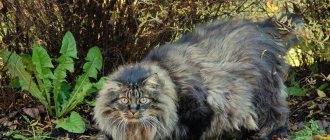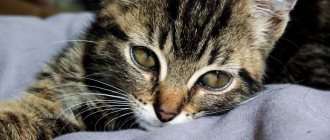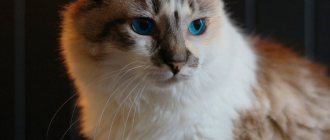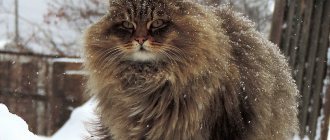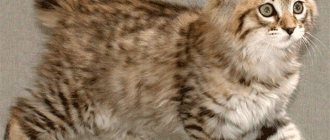The rarest cat breeds in the world are listed in the Red Book. This list includes the little-studied Caucasian forest cat, which lives in the countries of Central Asia, Eastern and Western Europe. She leads a secretive lifestyle and prefers hard-to-reach habitats.
What interesting things have experts learned about this rare breed, and what qualities attract the Caucasian forest cat? Is it possible to keep such a predator at home? You will find answers to these and other questions in our article today!
Habitat
Representatives of this species live in the Caucasus and Turkey. The animal inhabits Dagestan and Chechnya, the Krasnodar and Stavropol Territories, as well as North Ossetia and the Republic of Adygea. The habitat covers a small part of Armenia and Azerbaijan. The northern border in Russia is at 45 degrees north latitude.
Number
On the territory of the Dagestan Republic back in the 80s of the last century, there were only about 100 individuals of this species. Such a small number can be explained by intensive extermination in order to obtain valuable skins of these representatives of the cat family. Every year, more than 5,000 forest cats died as a result of hunting.
Nowadays, according to zoologists, the maximum possible number of individuals per 1000 hectares (10 km²) is 200-300 specimens, but on average this figure is much more modest - only 10-20.
Wild cats of the Krasnodar region occupy all its ecosystems. In the Caucasus and other habitat areas, their populations are small but stable. Ecologists keep accurate records of the number of individuals; it is extremely difficult to obtain such information, since this species prefers the most remote, difficult-to-pass forest lands.
Habitat
In the Caucasus, the animal lives at an altitude of approximately 2000 m above sea level; the forest cat prefers broad-leaved and coniferous forests. Near the Terek and Kuban rivers, the predator hides in the reeds. The animal loves remote areas, as it prefers to be invisible. Sometimes the forest cat hides in buildings or near houses. Often, hollows and crevices in rocks, and burrows of other species become shelters.
ATTENTION, TEST! Answer a few simple questions and find out what kind of owner you are for your cat:
Does your cat have a name?
How often do you play with your pet?
Do you get your vaccinations and parasite treatment up to date?
Is your kitten spayed/neutered?
What do you feed your purr?
Share your Results:
Facebook Twitter Google+ VK
Wild cats of the Krasnodar Territory and the Crimean region make up the largest population of these cats. Particularly high density is observed in the foothills.
Appearance
The Caucasian forest cat is a large animal. The body weight of males varies from 3.1 to 8 kg, in females this figure ranges from 3 to 6 kg. The length of the body in males is 50-67 cm, in females - 52-61. The predator's tail is long - approximately 20-30 cm. The animal's claws are sharp. The head has an oval shape. The length of the animal's ears is 7 cm, they are set wide and do not have tassels at the ends. The forest cat's eyes are large and have no eyelashes. The Caucasian forest cat has white 50-mm vibrissae, their number varies from 7 to 16. The animal's pupil is vertical, the iris is yellowish. The nose is pink.
The predator's fur is dense in winter. Usually the color is gray with red spots; on the ridge, as well as on the head, there is a black stripe. The throat, belly and groin area are reddish. An ocher tint is noticeable in the undertail area. There are gray spots on the belly of the predator. On the tail of the Caucasian forest cat there are black rings, there are 3-8 of them in total.
Rusty cat
Source:
The rusty or red-spotted cat, whose length including the tail is only 50-70 cm, and whose weight is about 2-3 kg, is the smallest wild cat in the world. Humans know practically nothing about this species, whose representatives lead an extremely secretive life. Unfortunately, despite this, the rusty cat has already managed to be included in the list of “vulnerable” species, since most of its natural habitats have now been turned into farmland.
What does it eat?
The forest cat can climb trees, but always hunts on land. The predator's diet includes rodents and lizards, birds and eggs of other species. In the Kuban River delta, the main diet consists of species such as water rat and muskrat. In the north of the Caucasus, the animal eats mainly mouse-like rodents. This animal can eat about 20 voles in one meal. The territory of each animal covers approximately 3 km2 of land.
In the event of a total shortage of the main components of the diet, the forest cat opens the hunt for hares with muskrats, pheasants and young horses. Sometimes a feline catches poultry. The forest cat also eats cereals with fruits, carrion and small insects.
Diet
The Caucasian forest cat is a medium-sized predator that is excellent at climbing trees and rocks. To hunt, the animal prefers to go down to the ground.
Most of its diet consists of rodents - mice, voles, dormice. I am ready to fight with such brave enemies as weasel, ermine, raccoon, rat, muskrat, nutria. Capable of catching a hare, snake, baby roe deer or deer.
Most of all he likes to hunt birds whose nests are located on the ground - pheasants, partridges, chukars, ducks.
Does not like to swim, but sometimes goes down to the water to catch fish, frogs or toads.
During the hungry season, it does not refuse lizards, insects, berries and herbs; it can enter human settlements and carry chickens, geese and turkeys, although it avoids people with all its might.
It does not move well in the snow, so it does not choose such areas for living and hunting.
The Caucasian cat eats a lot - an adult can eat up to twenty mice a day, and a teenager can eat about ten.
Reproduction
The rutting period begins at the end of winter - in spring. At this time, males wipe their secretions on the bark of trees to attract females. During the rut, fights among males do not stop.
The forest cat bears its cubs for about 70 days. Usually 3-5 babies are born. At the time of birth they are blind and helpless. The weight of the newborn is 40 g. Vision appears only on the 9th or 12th day. Incisors appear after two weeks, milk teeth are replaced by molars already on the 160th day.
Caucasian cat with kittens
Kittens are born covered with plump fur. The upper part of the body is light in color with brown spots. There are dark stripes on the hind legs. The cubs already have several black rings on their tails. At birth, there is a bright red spot on the baby’s nose. The mother feeds them milk for 4 months, but from the age of one and a half months the babies eat mice and rabbits and hares.
Already at 2 months, the cat teaches the cubs to hunt. At six months the males leave, and the females remain with their mother until one year - the onset of puberty. However, offspring often appear only at 3 years.
Taming the Far Eastern forest cat
Since Amur cats are only slightly larger than the usual domestic cat and look about the same, many exotic lovers have an irresistible desire to own such a fluffy cat. The only difficulty is that the blood of wild predators flows in the veins of this mustache. And the call of the ancestors can wake up at any moment.
Amur cats are almost impossible to train
Far Eastern forest cats are independent and willful
Not a single attempt to tame or train these furry predators has been successful. Moreover, such undertakings often ended in injury to the “trainers.” After all, if it is impossible to escape from people, the Amur cat instantly turns into an aggressor. And as you know, the fearlessness of an angry mustachioed cat knows no bounds.
A friend works as a huntsman in the Far East, he once picked up such a kitten (the cat died, most of the kittens too, this one survived) very small, still a milky one, he was completely exhausted, almost dead, well, he came out, fed him, he grew up and went to live in the forest has not taken root in the house, but it comes to visit regularly, it will come, eat it for free and leave, it will not be allowed into the hands of anyone, not even Yegor (the huntsman).
When purchasing a Far Eastern forest cat to live at home, you need to remember the following:
- such a kitty does not go “in your arms”;
- wild murka does not eat “from the palm of your hand”;
- the spotted cat will sleep during the day and wander around its assigned territory at night (if not retrained);
- During the mating period, aggression will intensify, which is why the animal can fill the house with heart-rending screams.
It is also important that even individuals taken at three months of age become wild as they grow and strive to return to their natural environment by any means.
Conditions of detention
Since this animal is listed in the Red Book, the official sale of Amur forest cats into private hands is prohibited. However, there are cases when animals still end up in the same home with a person - given by a zoo or picked up by a familiar hunter. Cases of smuggling are also not excluded. And then the owners need to decide on the living conditions of the wild predator in the house or even apartment.
It is advisable to keep Far Eastern forest cats in closed enclosures
Experts unanimously recommend limiting the living area of the Far Eastern forest cat to a spacious enclosure. It should have devices for climbing and jumping (beams, tree trunks and cuts, shelves), as well as a convenient “nest”. This can be made in the form of a house like a doghouse. In addition, you need to take care of the pet’s tray by filling the “toilet” with sawdust or sand.
Important nuance! According to Russian legislation, keeping Red Book animals in captivity, including Amur forest cats, is punishable by a fine of up to 1 million rubles. or forced labor for up to 3 years.
Lives great at home!!!!! Yes, he doesn’t often sit on his lap and purr, but ROARLS! But he feels great in the apartment and eats his mice and birds and meat. We got here by accident - the zoo didn’t accept us!!!! It was a pity to give it away to someone unknown! Stayed and feel great in a Moscow apartment! Doesn't tear up wallpaper, doesn't shit anywhere! It marks, but this issue has also been resolved - we put protective glass in the places where it marks - we remove it and there are no problems!
In the wild, Far Eastern cats cannot always afford to consume food every day. This is worth remembering when dealing with an animal that has come to a person as a pet.
Wild catfish from the banks of the Amur should be fed once a day, preferably at the same time. The diet should include poultry, lean beef, veal and rabbit
To maintain dental health, it is important to feed the animal mice and uncut bird carcasses.
In addition, once a week you can pamper your pet with the following food:
- raw chicken or quail eggs;
- sea fish (both fresh and boiled);
- boiled vegetables (pumpkin, carrots, zucchini).
But you shouldn’t give porridge to your pet - they can cause fermentation in the intestines and disrupt the functioning of the digestive system. You should also exclude milk, bakery products, alcohol, spices, fried and salty foods from the menu.
Animals must have access to clean drinking water.
Amur forest cats are difficult and brave animals native to the Far East. These animals have been cherished for a long time, and for lovers of exotic fluffy beauties they become a desirable trophy in the home nursery. However, we should not forget about the negative aspects of keeping a Far Eastern cat at home - the aggressive behavior of the purr and criminal liability for owning a Red Book animal.
I write articles on various topics
Lifestyle
The Caucasian forest cat is more active at night, but in summer the animal hunts during the day. The predator watches the prey for a long time, sitting in ambush, and then takes the game by surprise or begins the chase. If the victim is small, the forest cat grabs it with its claws and bites its neck. In large animals, the predator usually gnaws the carotid artery.
Life expectancy and health
On average, a forest cat lives about 10 years. However, some animals die at a young age. A small proportion of individuals reach old age; old age in an animal occurs at 12–15 years.
In the wild, the furry forest animal has many enemies. Among them, the most dangerous are wolves, lynxes, jackals, and less commonly, foxes and martens. Thanks to their physiology, the ability to move quickly, swim and jump far, they manage to avoid encounters with enemies.
Wild cats have an excellent immune system and do not have genetic diseases. With good care in captivity they can live more than 25 years.
Life in captivity
The Caucasian forest cat loves freedom and has a strong character. The animal is often aggressive and can bite, so it is better to choose kittens from nurseries. The predator's diet should consist of fresh meat and fruits.
As a rule, domesticated felines differ from their wild relatives in size: they are smaller, their teeth are not so sharp. Such forest cats can be transported in a carrier, and there is no fear of leaving them with children and training them.
Hunting
The Caucasian forest cat may try to catch hamsters, rats and mice in the house, as well as chase birds.
Purchasing a kitten
A kitten should only be purchased from a professional breeder. The cost starts from 35-40 thousand rubles. In foreign nurseries, prices are much higher.
You should think a hundred times whether such an unsociable, restrained in showing emotions, but at times aggressive pet is needed in the house.
In addition, as an endangered species, the Caucasian forest cat is listed in the Red Book of the Russian Federation. Its illegal acquisition and maintenance is punishable by law.
1111
Interesting Facts
- In the past, wild forest cats guarded people's homes and were actively used for various purposes in war. These animals were quite expensive, they cost as much as a full-grown bull.
- According to evidence, Caucasian forest cats were seen already during the reign of the Duke of Wales. They began to be domesticated about 3,000 years ago.
- Forest cats usually hiss when they are angry, but they can also meow.
- Animals often migrate in winter.
- In winter, forest cats lose weight, and in summer they gain weight, increasing their body weight several times.
- The maximum lifespan is 21 years, but cats usually die at 13 years of age.
- The animal often makes 3-meter jumps while hunting.
- The Caucasian forest cat sheds twice a year.
- Where the forest cat is in proximity to the jungle cat, it often settles in the so-called “mountain” forests, which are located on the slopes of the mountains.
- This feline swims well, but when “retreating” it hides only in hollows.
- In the Colchis Lowland, near Batumi and Poti, forest cats have to walk through mud and wet grass, they constantly swim across fast streams.
History of the origin of the breed
The era of the Quaternary period - the Pleistocene, which began more than 2.5 million years ago and ended approximately 11.5 thousand years ago, according to scientists, is the time of the emergence of the wild cat. Based on these figures, it is obvious that the wild cat is “older” than humanity, which arose about 2000 years ago; scientists do not know what it might have looked like at that time.
Typical wild forest cat
The end of the Ice Age, harsh climate, terrible weather conditions, followed by global warming, influenced the emergence and further development of the wild cat class.
